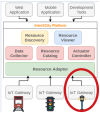Co-Simulation of Interconnection Between Smart Power Grid and Smart Cities Platform via Massive Machine-Type Communication
- PMID: 40096395
- PMCID: PMC11902400
- DOI: 10.3390/s25051517
Co-Simulation of Interconnection Between Smart Power Grid and Smart Cities Platform via Massive Machine-Type Communication
Abstract
With the advent of Industry 5.0, the electrical sector has been endowed with intelligent devices that are propelling high penetration of distributed energy microgeneration, VPP, smart buildings, and smart plants and imposing new challenges on the sector. This new environment requires a smarter network, including transforming the simple electricity customer into a "smart customer" who values the quality of energy and its rational use. The SPG (smart power grid) is the perfect solution for meeting these needs. It is crucial to understand energy use to guarantee quality of service and meet data security requirements. The use of simulations to map the behavior of complex infrastructures is the best strategy because it overcomes the limitations of traditional analytical solutions. This article presents the ICT laboratory structure developed within the Department of Electrical Engineering of the Polytechnic School of the Universidade de São Paulo (USP). It is based on an architecture that utilizes LTE/EPC wireless technology (4G, 5G, and B5G) to enable machine-to-machine communication (mMTC) between SPG elements using edge computing (MEC) resources and those of smart city platforms. We evaluate this proposal through simulations using data from real and emulated equipment and co-simulations shared by SPG laboratories at POLI-USP. Finally, we present the preliminary results of integration of the power laboratory, network simulation (ns-3), and a smart city platform (InterSCity) for validation and testing of the architecture.
Keywords: co-simulation; distributed computing; massive machine-to-machine-type communication; smart cities; smart power grids.
Conflict of interest statement
The authors declare no conflicts of interest.
Figures








References
-
- MDPI Special Issue: Vertical iot Solutions and Their Applications in Smart Cities, Smart Agriculture, Smart Environment and Disaster Management. 2024. [(accessed on 20 September 2024)]. Available online: https://www.mdpi.com/
-
- Cisco Cisco Visual Networking Index: Forecast and Trends, 2017–2022 White Paper. [(accessed on 29 August 2024)]. Available online: https://www.cisco.com.
-
- Bahmanyar A., Jamali S., Estebsari A., Pons E., Bompard E., Patti E., Acquaviva A. Emerging smart meters in electrical distribution systems: Opportunities and challenges; Proceedings of the 2016 24th Iranian Conference on Electrical Engineering (ICEE); Shiraz, Iran. 10–12 May 2016; pp. 1082–1087.
-
- Barbierato L., Estebsari A., Bottaccioli L., Macii E., Patti E. A distributed multimodel cosimulation platform to assess general purpose services in smart grids. IEEE Trans. Ind. Appl. 2020;56:5613–5624. doi: 10.1109/TIA.2020.3010481. - DOI
-
- Del Esposte A.d.M., Santana E.F.Z., Kanashiro L., Costa F.M., Braghetto K.R., Lago N., Kon F. Design and evaluation of a scalable smart city software platform with large-scale simulations. Future Gener. Comput. Syst. 2019;93:427–441. doi: 10.1016/j.future.2018.10.026. - DOI
LinkOut - more resources
Full Text Sources
Miscellaneous

